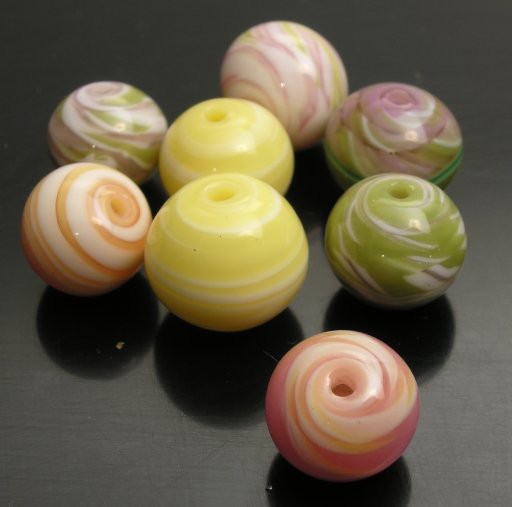Way back when (say, a decade ago) there was not quite the range of glass there is today for lampworkers, and I tried just about everything out there to get the the purples, pinks, off-whites and mossy greens I particularly liked and were then mostly unavailable in Moretti (now Effetre). One of these experiments was Satake, a Japanese glass, which comes in lead and sodalime versions. The lead glass has a COE of 120, making it worlds softer than anything else out there; the sodalime is rated at 113, so of course all the wisdom is that you don't mix them.
Of course, the first time I saw someone demo this stuff, in a core vessel, he immediately mixed ’em, because there is no red in the lead satake palette. (He also was given Effetre by mistake, and so had to pick that off his core. Considering the guy was demoing in a foreign language, I thought he carried this off with great aplomb. As I recall, Emiko Sawamoto translated. Also he had this very cool set of rollers made out of the wheels from shower curtain tracks. The core, btw, was steel wool coated with bead release. Smoothing that looked like a great way to exfoliate the skin off your palm.)
So my earliest blue-violet beads were made with Satake (now, of course, both Bullseye and Effetre make very nice neo-lavenders.) I never really did get very good at using this glass, and stopped using almost entirely when the transparent pinks and purples became available in other brands; I got a lynx, which has a very sharp, hot flame; and Arrow Springs stopped carrying Satake. I don't especially get along with the only current US vendor (because I really don't appreciate being made to pay sales tax on something I'm gonna resell, not to mention sloppy invoicing.)
Ah, but at this point you're wondering what this post has to do with overdue obligations. Well, as I've said, I haven't made satake beads for ages, so why now? Well, last gathering (that I attended, in 05) Cindy Jenkins was looking for bead artists to make beads for a hothead book she's putting together. She needed the beads by September. Fair enough. Now, even though I've used a hothead about six times in my entire life, I was intrigued by this project, because there is at least the perception amongst some dual-fuel torchers that hotheads are hardly worth the bother; and I wanted to support the ‘loud and proud’ contingent. I figured since I've tried a variety of torches at Open Torch, and used many differing glasses, that I could adapt.
Furthermore, I thought the soft, rather unfocused flame, with just air mixing, would be ideal for satake glass, which is traditionally used with a very low pressure fuel gas-only torch, supplemented with an aquarium style air pump. And I did make a few beads using satake and the hothead, of which these are the best. I even got ’em done by the deadline. —However they're not very good, and I didn't think they were worth of Cindy's book. I made some other beads too, equally unworthy, and meanwhile the noise from the hothead, not to mention the flame characteristics, were making me batty, so I gave up on the project: I'd gotten too used to my lynx. So much for my vaunted flexibility.
I still believe that satake is a good glass for the hothead, even though I haven't developed this theory, and only got around to photographing these beads (that to be perfectly honest I'm only 95% willing to swear were made on a hothead) a year later. Definitely a whiff of failure, here, oh well...
Page, however, really likes the torch (as indeed a great many other people) precisely because of its cooler working temperature. (Alas, she's not willing to share her creations either, and in any case, she's working with Effetre, and when I'm feeling really evil, PIG. Only would I subject my best friend to this horrendous glass. The amazing thing is that she puts up with it.)
Since I never sent Cindy any beads, I figure owe her—besides an apology for being such a flake—for a hothead torch she kindly provided free of charge to make the beads. And if anybody's interested in Satake, I'd be happy to sell the 20# or so I have for half of what I paid (which was $50/lb, ouch.)
file created 07sep06
Unless otherwise noted, text, image and objects depicted therein copyright 1996--present sylvus tarn.
Sylvus Tarn